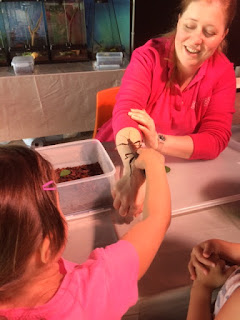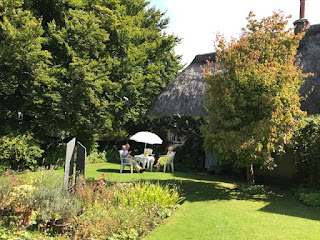We were in Dorset for the weekend so decided to visit Thomas Hardy's cottage - a hidden gem of the National Trust. We chugged up the lane to Higher Bockhampton where Hardy was born in 1840, in a stone cottage under Thorncombe Wood. We parked, and after calling at the Visitor's centre to register for a timed visit, we approached the cottage through the wood, where paths have been laid through the landscape of his childhood - beech trees, sink-holes, a winding Roman road and a pond on a hill where a wild white pony stands. All these things Hardy captured in the lyrical poems he wrote throughout his life; his first recorded poem, "Domicilium" is about this house and it's surroundings.


Inside the cottage it is a simple place of whitewashed walls and bare stone floors. There's a wooden settle by a smoking hearth, china dogs on the mantle, and willow pattern dishes on a dresser. Upstairs are three small bedrooms - one for girls, one for boys, and one for parents. In the latter is a replica of the rough white table at which Thomas wrote his first four books - in this room - including Far From the Madding Crowd. This was the breakthrough novel that allowed him to leave home and marry.
The volunteers who work here are very passionate and can definitely provide you with plenty of information.
It is in an idyllic spot in the wood and quite beautiful. The aura and atmosphere in the cottage and the garden are such that you can imagine Thomas Hardy and his family going about their daily business. Visit the garden shed and watch the film, it is delightful and gives such a wonderful insight into Hardy's life and times.
Next stop was Max Gate. This is the National Trust property of Hardy's Victorian villa on the edge of town. It's a sturdy red-brick mansion which he designed himself in the years of literary success, with turrets at each corner and was built by his father and brother. Unfortunately, in accordance with his Will the furnishings were all sold at auction, as was the property, so all but a few items are not the original pieces. The drawing room has chintz chairs by a vast, dark fireplace. The dining room has heavy chairs and flame-coloured walls. In the attic is a separate suite of rooms that Hardy's first wife, Emma, moved into, halfway through their marriage. It does not feel like a happy home.
It was interesting to see his home, and to learn about him in later life from the knowledgeable volunteer and guide books which are available on tables as you walk around the house.
After a lovely Sunday lunch in a nearby pub we drove on to T. E. Lawence's (better known as Lawrence of Arabia) home, Clouds Hill.
If you are looking for excitement, fireworks, fun and frolics....don't venture to Clouds Hill!
However, if you want a sense of the solitude and the life T.E. Lawrence made for himself (sporadically) in Dorset, the essentially academic and private man who entertained predominantly literary figures, a sense of the quirky perfectionist who went to the trouble of installing a bath and lining rooms with cork and aluminium yet used a shovel and the garden for a loo....you have come to the right place.
From his library collection (sadly, none of the books at the house are his originals but purchased using an inventory of his library), to his self-designed reading chair including flat arms for a cup of tea in his self designed cups and book holder - it becomes apparent how such a perfectionist can have lived a life of such discontent.

The cottage - complete with the inscription "why worry?" in Greek, over the door is not much bigger than a garden shed and was built for a Forester in the early 19th century. In the 1920s TE Lawance rescued it from dereliction as a refuge from his own fame. It became his sanctuary in a restless life. The cottage still has no electric light. And, as National Trust volunteers will testify, it is often bitterly cold, despite Lawrence's attempt at installing a homemade insulation of asbestos and tin foil. The sleeping space was two woollen sleeping bags embroidered with the words meum and tuum - mine and yours - on a sort of leather shelf. George Bernard Shaw is said to have used it on at least one occasion.

Lawrence trained as an archaeologist, and was recruited as an intelligence officer in the war because of his wide travels in the Middle East, and his fluent Arabic. He went on to help organise and fight in an Arab revolt against the Ottoman empire. Although many of his commanding officers found him impossible to deal with, General Sir Edmund Allenby said he should be given a free hand: "He was the mainspring of the Arab movement and knew their language, their manners and their mentality."
In May 1935 Lawrence rode away from Clouds Hill on the last of his series of powerful Brough Superior motorbikes and died in circumstances that are still debated. Officially he skidded trying to avoid two boys in the road, but some believe he killed himself. He died in hospital days after the crash. In 1937, the cottage and many of its contents were given to the National Trust by his brother AW Lawrence as a memorial.

We then drove on to Rosemary and Furse Swann's beautiful Yoah Cottage,with private guest wing in a stunning garden (apparently it was originally for the shepherds) where we stayed for two nights with our very good friends Tony and Pauline. Yoah Cottage is a charming 17c thatched cottage that does bed and breakfast in the attractive village of West Knighton. with lovely views over the garden and rolling farmland. The cottage is thatched and built of stone and cob with exposed beams, old antique furniture and inglenook fireplaces We also had our own beautiful sitting room with log fire but the weather was delightful so we didn't need it. Breakfast was generous including home-made jams and marmalades and fruit from the garden.
Rose and Furse are the friendly owners, potters and have created a charming, art-filled home. They are ceramic sculptors; Rose makes delicate, sometimes humorous pieces, Furse creates bold animals and birds; their thatched, rambling house is a jaw-dropping gallery of modern art, ceramics and fabrics. The prettiest of cottage gardens brims with colour and scent.
Such warm-hearted, artistic owners - and you're deep in Hardy country.
Tel: +44(0)1305 852087
And the reason for our visit to Dorset. We were here to celebrate a special occasion. Clive's 65th birthday and retirement. And what's a birthday if you can't have a party. Rosie had taken over an amazing property and filled it with Clive's lovely family, including Mark, Clive's brother and his wife, Sindy from Portland, Oregan and Carol, Clive's sister, and husband Paul who had travelled from France. It fitted the bill perfectly, plenty of room for the grandchildren and numerous dogs to roam around the garden and the in-house chefs (Clive's daughters Michelle and Sharon) prepared a lavish banquet. The weather was also amazing. Thank you Clive and Rosie for inviting us to share your special celebrations.
Wishing you a Happy Retirement.
The next day, on our way home, we spent an enjoyable morning wandering around the grounds of Sculpture by the Lakes discovering the interesting sculptures dotted around the lakes and gardens. There was a real sense of peace and tranquillity and it was a pleasure to explore the beautiful scenery.
The park is showcasing the work of sculptor Simon Gudgeon with enormous bronze statues appearing in natural settings. Some in the lakes, some in woodlands, some in the garden, but all sympathetically positioned to blend in with the landscape. Everywhere we saw electric blue Damsel Flies darting about, many butterflies as well as birds.




































































